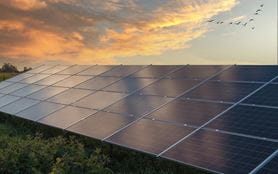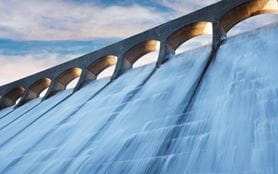COP27: Reaching for opportunities in an energy crisis in South Africa
Related people
Press contacts
For media enquiries relating to this topic, please contact:
Headlines in this article
Related news and insights
News: 13 July 2023
Publications: 16 November 2022
Publications: 11 November 2022
COP27: Morocco – great progress, but more to do in energy transition
Publications: 10 November 2022
COP27: Putting energy transition back on track in North Africa
Renewable energy and market reforms are helping to take the pressure off South Africa’s broken electricity system. But as Alessandra Pardini and Alexandra Clüver, partners in A&O’s Johannesburg office, tell Head of the Africa Group and Co-Head of the Global Projects Practice Tim Scales, the wider challenges are immense and it’s time to turn talk into action.
Tim Scales: In South Africa, energy transition is being driven mostly by private independent power producers, coupled with some significant sector reforms. How do you see this evolving?
Alessandra Pardini: Yes, at the moment energy transition is about private power and it’s really about how the COP conferences and ESG initiatives are forcing companies to look in the mirror and ask: how can we look greener to transform our reputation and brand?
That’s largely being done by investments in renewable energy and in the last two and a half years we’ve seen massive investments by a range of mining companies and manufacturers, including Anglo American, Tronox Mineral Sands, Impala Platinum, Rio Tinto, Samancor, Sasol and Glencore, for example. These are huge, utility- scale renewable projects.
The most recent one is by Tronox – a titanium miner – which has closed a 200MW deal. It’s the largest private solar deal on the continent to date, although it will be surpassed very shortly by deals being looked at by Sasol, Air Liquide and others.
It’s a huge change from five years ago, when legislation meant that any project bigger than 1MW had to apply for a generation licence, which was very hard to get. Now the cap has been lifted to 100MW and the government has said the cap will soon be removed altogether.
Alexandra Clüver: Draft legislation is out for the removal of the cap. But you have to realise it’s a case of killing two birds with one stone.
The state utility ESKOM is struggling to keep the lights on. We are experiencing rolling blackouts on a regular basis – four hours on, four hours off. For a lot of these heavy users of electricity from ESKOM the lack of certainty, coupled with the ESG/net-zero narrative, has only added to the imperative for many of them to go out and procure renewables alongside their grid connection.
It is part of the response to the energy crisis we are suffering and that’s why the government has moved so quickly to increase and ultimately lift the cap, allowing the private sector to take some pressure off the state utility.
Alessandra Pardini: The electricity system is pretty broken. Most big office and retail blocks have some sort of back-up power from diesel generators. The reason we didn’t see the market being liberalised earlier is because the thinking was typically that the only way to save ESKOM was to prevent others generating for private use. Thank goodness that philosophy changed.
Tim Scales: But currently the power being produced by these projects is just targeted for own use by industrial customers?
Alessandra Pardini: At the moment, it is being produced for dedicated off takers like big mining companies or heavy industrial users only. That being said, the company will often have a dependent community that benefits from the offtake.
We have also seen trading licences issued in the recent past. Smart money is definitely thinking about trading, aggregating and the future energy landscape. We expect private equity-backed energy and infrastructure funds will take a more bullish approach to smaller projects and create merchant-type risk markets.
Alexandra Clüver: In addition, one of the most recently touted solutions is for ESKOM to acquire the excess power produced by these independents. It’s an idea that has only just been articulated in the last few weeks as part of the overall response to the energy crisis.
Tim Scales: Is this “captive power” model, with excess power being sold into the grid, an approach you can see being used more widely on the continent?
Alexandra Clüver: Captive power serves a different purpose in other parts of Africa. The challenge is huge. If you look at sub-Saharan Africa and you remove South Africa’s installed power generating capacity from the equation, then you are left with 48 countries having roughly the same installed capacity as Germany.
Alessandra Pardini: Or put another way, if you look at the rest of the continent outside South Africa, you are talking about 1 billion people having the same access to energy as Germany, which has a population of 83 million. That’s a stark contrast.
Alexandra Clüver: I think captive power could be the answer in other parts of the continent, but you must remember you don’t have vast installed grid capacity elsewhere and utilities are often in a worse state than ESKOM. In South Africa we do have a national grid, so a wind farm in one region can supply a mine at the other end of the country. That’s not the case generally across the continent. So, you’d be looking at off-grid and behind-the-meter solutions such as rooftop developments, which we are seeing across Africa.
Tim Scales: But can renewables fill the gap completely and how quickly?
Alessandra Pardini: Africa has very rich fossil fuel resources. Mozambique, for instance, has significant amounts of gas, although since last year’s terrorist attacks in the north of the country there is more political uncertainty over its industry. West Africa has huge oil reserves, and South Africa has coal. Given the global decarbonisation targets, these fuels are often perceived as problematic. I don’t think they will ever be developed as was once envisaged and Africa will be left to stand in the already congested queue for LNG and other interim solutions.
But since Russia invaded Ukraine, there’s been a shift. Suddenly Europe was allowed to turn on its old coal stations and people in Africa were left thinking: hang on, we can’t build a new coal-fired station because no- one will finance it! Worse still, the price of coal shot up from roughly USD100 to USD450 a tonne and Europe bought up all our coal, so we are struggling with more limited supplies, further exacerbating rolling blackouts.
Alexandra Clüver: Instead, we’re buying diesel at great expense, which doesn’t make a whole lot of sense!
Alessandra Pardini: The Ukraine war has boosted coal sales, but we still don’t have enough power. But I do wonder if the conflict will shift the conversation on coal, globally. Is there a way to develop clean coal-fired power stations with carbon capture technology? Without the conflict we wouldn’t have been having this conversation because up to now no-one could build new coal. Is there still a role for thermal energy in Africa? We represent just 2% of emissions globally, so I think it would be very unfair to say there isn’t.
Alexandra Clüver: It’s a complicated question because of the issue around access to installed power. Given the vast distances you have to cover, you probably wouldn’t be building grids to connect huge renewable power plants to users. It doesn’t work inmost of Africa where you have lots of rural communities, often huge distances apart. It might work in urban areas, while elsewhere mini-grids might make sense. But then you’ve still got the problem of variable power production from wind and solar. Batteries could solve the problem but are still very expensive. Diesel generators are not a good idea. So maybe there is a role for thermal power in electrifying urban areas if you can build plants that generate in the cleanest way possible, using renewables to plug the gaps. The cost of carbon capture utilisation and storage (CCUS) is still an issue, but this may change if the energy prices and inflation continue to rise.
Alessandra Pardini: The South African government wants to build renewables as quickly as possible, because it is behind on its clean energy targets. But procuring gas is also part of its integrated resource plan. I think much of the rest of Africa will, similarly, look to procure gas, at the very least.
Alexandra Clüver: In a crisis there are always opportunities to be grasped. And it’s important not to underestimate Africa’s ability to embrace and adapt cutting-edge technologies. Just look at what it did with internet connectivity and mobile communications, where it leapfrogged Europe and led on innovative uses of these technologies just because it had to get there faster.
In scenarios like the one we are facing, there’s always an opportunity to do things creatively and to come up with solutions that are right for the continent. And there is another very important impetus – electrification really is a baseline for all other forms of economic development. The wider development needs are vast. In that sense, I don’t think renewables on their own can provide the answer to giving millions of people access to electricity.
Tim Scales: Of course, one important new element of the energy transition story is green hydrogen. How do you assess its potential within Africa?
Alessandra Pardini: The hydrogen story, at the moment, is about Europe investing in Africa to develop hydrogen resources and it’s a phenomenal opportunity for the continent. It will create new industries and more jobs and boost economic growth.
My hope for COP27 is that Egypt will signal that it is going to develop some of the projects it has signed memoranda of understanding on.
Alexandra Clüver: The hydrogen story is ultimately a very good one. Africa generally, and in the north and south in particular, has phenomenal wind and solar resources and is in pole position to develop green hydrogen. So it’s not surprising it’s being touted as one of the key solutions to achieving net-zero. It’s going to be used extensively in a whole series of industries like transport and manufacturing and Europe will be one of the main users and the biggest investors in the region because they don’t have the huge renewable energy resources to produce it. For that reason, it’s a massive play for Africa and we are very keen to assist, taking into consideration our role on various Middle East projects.
Tim Scales: what’s standing in the way of progress – or turning words into actions as you put it?
Alexandra Clüver: We’re seeing a lot of feelers being put out at the moment. Countries are signing MoUs with developers and investors and we are hopeful some of these will turn into projects.
We need to move fast. These projects are enormous, usually several gigawatts large. It takes a huge amount of investment to get them off the ground. In Africa, there are always going to be governmental, regulatory and financing hurdles to overcome. So, if you are looking at bringing projects on stream by 2030, we are already on a tight deadline and things need to get moving quickly.
Alessandra Pardini: The danger is we could see what some call “resource colonialism”, because we’ll produce all the hydrogen to give it to Europe, but will we be left with anything ourselves?
Alexandra Clüver: That’s a really important issue. Green hydrogen requires massive amounts of renewable power. In South Africa renewable energy is urgently being sourced, and that’s great. But if you say we’re going to build 5GWs of solar power to fuel an electrolyser to produce hydrogen gas that will be shipped offshore, that’s a hard sell politically.
Domestic use of hydrogen won’t, on its own, be enough to get projects financed. But there must be a middle way. There needs to be an approach that revolves around domestic to supplement export. We need to make sure that the countries hosting these production facilities get the right to capitalise on green hydrogen as well.
Tim Scales: Who’s leading the charge on green hydrogen?
Alessandra Pardini: We expect companies who will ultimately be using this clean energy will be in the saddle at first – big transport and petrochemical companies, for example, who will use hydrogen to meet their own net-zero targets. Anglo American, for instance, has run a pilot project producing green hydrogen to power its heavy mining trucks and it is now rolling this out more widely. We all expect green marine and green aviation fuels to lead the way.
Alexandra Clüver: Other investors circling around green hydrogen are a little bit more cautious as they try to work out where to invest and which projects to finance. In the end it is likely to be investors joining up with companies that have a real need for this fuel – whether that’s big steel, shipping or aviation operators – who will drive this forward.
As we said earlier, the Ukraine war has given a new impetus to energy transition and hopefully it will force people to think of alternatives faster. A lot of early conversations were focused on the high cost of producing green hydrogen, compared with blue or grey hydrogen, which are produced using fossil fuels.
But given what’s happening to global energy prices, and the fact that the price of gas and coal are so out of kilter, we will probably get to price parity sooner. Hopefully that will encourage people to invest in green hydrogen quicker.







